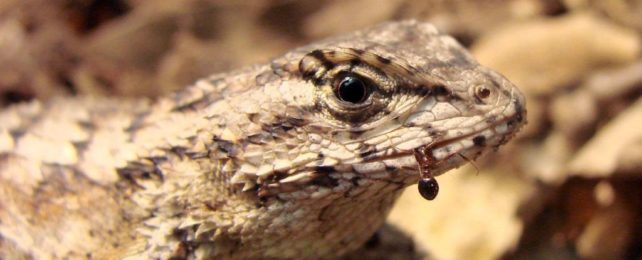A new study has found that lizards that eat fire ants – a venomous, invasive pest found in many parts of the world – could gain a measure of protection against their stinging bites.
By digesting and processing the ants and their venom, the lizards' immune system may become primed to fight it, a bit like having an ant venom vaccine. This suggests native species can adapt to protect themselves against the invaders, allowing them to coexist rather than be eradicated by changing ecology.
"We know that lizards from areas with fire ants have different immune profiles than lizards in areas without them," says biologist Tracy Langkilde of Penn State.
"Because the immune system is so critical for survival, we wanted to determine if these differences in immune profiles can be directly attributed to lizards frequently being stung by fire ants, eating fire ants, or something else."
The study was conducted on eastern fence lizards (Sceloporus undulatus), which are native to the eastern US. Fire ants (Solenopsis invicta) are native to South America and considered an invasive pest in the US, their bites triggering an immune response in a wide range of species.
For eastern fence lizards, a sufficient dose of fire ant venom can be fatal.
The ants have been present in the same range as the lizards for 70 years, and scientists noticed that these lizards have a different immune profile from eastern fence lizards that don't live near fire ants. So they conducted a study, exposing these latter "naive" lizards to fire ant venom.
For a period of three weeks, one group of 17 lizards was fed fire ants (the Fed group), and another group of 18 lizards were bitten by fire ants (the Stung group), three times a week. When the three weeks were up, the lizards were assessed for six different measures of immune response.
"We conducted a comprehensive assessment of most branches of the immune system, including measures of the innate immune system – resources that an individual is born with – and the adaptive immune system, which develops immune resources after exposure to a foreign substance like an infection or vaccine," says biologist Catherine Tylan of Penn State, who led the research.
"This allowed us to see how different immune resources are allocated in response to fire ant exposure."
Compared against the Stung group, the Fed lizards had three elevated immune measures. They had an increase in a type of white blood cell called basophils, responsible for inflammatory reactions during an immune response; an increase in an immunoglobulin antibody (IgM) that is known to respond to fire ant venom; and an increase in complement activity, which supports the body's immune response.
All three of these heightened responses would help the lizard's immune system fight against fire ant venom, Tynan notes.
"For example, the fire ant-specific antibodies and complement could help bind up venom so it can no longer negatively impact the body," she says. "It's possible that exposure to fire ant venom from the consumed fire ants stimulates an increased immune response, acting somewhat like a vaccine. So, eating fire ants may incidentally help lizards prepare for future venom exposure from stings."
When the researchers then compared their Fed lizards against wild lizards living in areas with fire ant infestations, they found several similarities in their immune profiles, compared against naive lizards. Specifically, the higher basophil and fire ant-specific IgM counts were similar across both groups, suggesting that these markers are a result of eating fire ants.
However, there were some differences, too. It's possible, the researchers said, that some immune measures observed in field lizards might be the result of stress induced by fire ant encounters. Or even something that has nothing to do with fire ants at all.
Determining how fire ants alter the immune profile of the lizards gives us information about one way in which native species can adapt to changing ecological conditions.
"The potentially protective effects of sub-lethal consumption of toxic/venomous invasive species," the researchers write in their paper, "may allow native populations to survive and coexist with these otherwise deadly invaders."
The research has been published in Biological Invasions.
